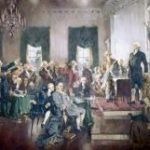You will find a suite of activities for families, teens and educators to celebrate Earth Day. Take on a Green Challenge to design a creative solution for an environmental issue, explore examples of climate activism, and learn how legislators consider a climate-ready policy issue.
Redistricting & Gerrymandering Lesson Plan
In this lesson, students will learn how state legislatures and governors can manipulate the redistricting process to gain an advantage for their party in the U.S. House of Representatives and state legislatures. Students will learn what constitutes gerrymandering and the typical types of gerrymandering used. Students will role play state legislators and collaborate to draw both gerrymandered and not gerrymandered districts. Students will consider the foundational redistricting case Baker v. Carr (1962) and classify arguments made in the case. In addition, students will evaluate the proper role of the Supreme Court in state redistricting cases.
The Constitution as a Fulfillment of the American Revolution

This short video challenges the notion that the Constitution was a conservative reaction to the democratic ideals of the American Revolution. The Revolution generated constitutional discussion in the states, where legislators explored the nature of executive power, and other constitutional questions. In light of this constitutional innovation, Professor Jack Rakove maintains that the Constitution of 1787 was the culmination of—not a reaction to–the Revolution of the late 1770’s.
James Madison and Proportional Representation

This short video highlights James Madison’s commitment to proportional representation in the newly-created Congress. However, he did not believe that the size of a state alone played an overly significant role in the decisions of either its citizens or its legislators. Professor Jack Rakove explains how Madison understood the various self-interests of all states and how he tried to account for this variation in crafting the new Constitution.